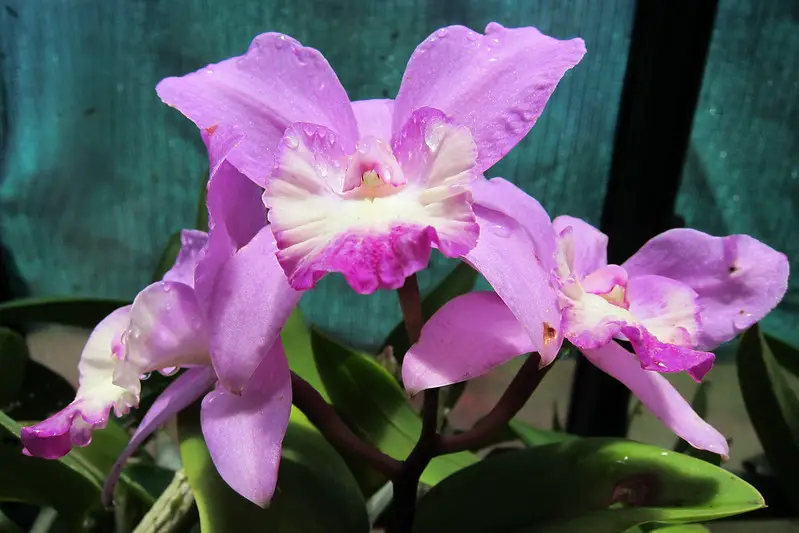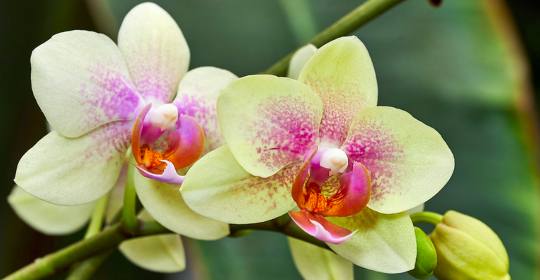We use affiliate links to run our site. When you buy through links on our site, we may earn an affiliate commission, without any added cost to you. Learn more
Orchids are strangely fascinating. They’ve long been a favorite among gardeners since they’re so delicate and beautiful. But, what most folks don’t know is whether orchids are parasitic or not.
The simple answer is that they only seem to be. Interested? Read on we have some interesting information for you.
Are Orchids Parasites:
Orchids are confusing and are often mistaken for parasitic plants. They grow on other plants and feed off of them. This is similar to what a parasite does in that they feed off of the host. There is a big difference between them, however, which brings us to our next point.
What Is A Parasite?
In the context of biology, the word parasite refers to an organism that lives in or on another organism (called its host) and benefits by deriving nutrients at the host’s expense.
Parasites do not usually kill their hosts, but they can reduce their host’s ability to compete for resources and eventually kill them. Some parasites are capable of being transmitted between hosts.
Parasites are a common occurrence among animals as well as plants. A parasitic plant is a plant that derives some or all of its nutritional requirements from another living plant.
The host is commonly known as the victim and in most cases, it suffers some kind of injury or loss as a result of being parasitized by another plant.
Can We Call Orchids Parasites?
There are more than 20,000 species of orchids that display a wide range of growth habits, including epiphytes, lithophytes, terrestrials, and saprophytes.
While orchids are sometimes called “parasitic plants,” they are not true parasites. They grow on other trees but do not cause harm to these plants.
Epiphytes absorb water and nutrients from the air and rainwater rather than from other plants. They derive their food through photosynthesis alone.
Orchids don’t suck the life out of the host as true parasites do. Instead, they use the host for support only.
How Do Orchids Grow?
The Orchidaceae family has a huge variety of species, and they can be found in almost all parts of the world. Some are terrestrial (growing in soil), while others are epiphytes (growing on trees). There are also lithophytes (growing on rocks) and saprophytes (living on the decaying matter).
Furthermore, they can be monopodial or sympodial. Monopodial species grow along a single stalk, while sympodial species form new growths at the base of the plant.

Epiphyte Orchids:
In nature, most orchids are epiphytes. As such, they grow on trees without actually depending on them for food. Instead, they use their roots to attach to tree branches and absorb nutrients from the air, rainwater, and organic debris that falls through the leaves.
Terrestrial Orchids:
Some orchid species grow in soil like any other plant. They have roots that help them absorb water from the ground and get nutrients from the surrounding soil. They need regular watering just like any other terrestrial plant—but you should avoid overwatering them!
Lithophyte Orchids:
Lithophyte orchids grow on rocks, with their roots attaching themselves to cracks in rocks, as well as any organic matter that has collected there between rains.
Saprophyte Orchids:
Saprophytic orchids are photosynthetic and therefore need sunlight to survive. But they can’t rely on photosynthesis alone to provide all their nutrients. These types of orchids have developed a way to get around this by breaking down organic matter.
Parasitic Orchids:
Some orchids are known to use specialized structures called haustoria to penetrate the bark of their hosts, but this is a complex process that requires many years of development before it can be successful.
Once penetration occurs, the orchid obtains sugars and nutrients from its host, but there is no evidence that any orchid actually kills its host.
Parasitic Plants:
Parasitic plants derive some or all of their nutrition from another living plant (the host). They germinate, attach to the host plant, and obtain water and nutrients from the host.
This type of interaction is different from mutualism, in which both species benefit from each other, or commensalism, where one organism benefits but the other is unaffected.
Parasitism is characterized by one organism deriving nourishment from another without providing any benefit to the latter.
Parasitic plants are classified into holoparasites and hemiparasites.
Holoparasites are completely dependent on the host for water and nutrients, while hemiparasites get part of their nutrients from the plant.
The best-known parasitic plants are:
Corpse Flower:
The corpse flower is the largest single flower on earth. It is a parasitic plant, with no visible leaves, roots, or stem.
The corpse flower is a flowering plant that emits a strong odor of rotting flesh. The plant is native to Sumatra and can grow up to 10 feet tall.
The smell draws insects such as flies, which assist with pollination. This rare plant blooms only once in several years
Australian Christmas tree:
The Australian Christmas tree is a parasitic plant found in Western Australia. The tree is actually a woody vine that grows on other trees and extracts nutrients from them. Being a parasite, the Australian Christmas tree relies on its host for water and minerals
Dodder (Cuscuta sp.):
Dodder is a parasitic plant that grows worldwide. It attaches itself to other plants using haustoria, tiny root-like structures that penetrate the host’s tissues. Once attached, the dodder absorbs its food from the host by stealing its water and nutrients
Thurber’s stemsucker:
Thurber’s stemsucker is only about 6 mm (0.25 inch) long and lives entirely within the stem tissues of its hosts and lacks roots, leaves, or chlorophyll.
It is native to the deserts of southwestern North America, where it parasitizes the stems of shrubs in the pea family (Fabaceae). As they don’t have any roots, leaves, or chlorophyll, they get their water and nutrients from the host.
Mistletoe:
The mistletoe is a hemiparasite (a partial or “half” parasite), which means it only takes one type of resource from its host: water and minerals. It has its own green leaves with which to make food by photosynthesis.
They use their root-like structures to penetrate the host plant’s bark and extend into its conductive tissue and absorb water and nutrients.
Mistletoes can be found in branches or trunks of hosts including oak trees (Quercus species), eucalyptus trees (Eucalyptus species), fir trees (Abies species), and pine trees (Pinus species).
They produce beautiful flowers that range in color from yellow to white to red.
Conclusion:
Orchids do not belong to either of these two groups. They are not parasites because they do not absorb any nutrients or water from a host plant.
Orchids have evolved to live in a symbiotic relationship with fungi that live in their roots; the orchid provides the fungus with carbohydrates and the fungus provides the orchid with essential nutrients.
I hope this post has cleared every doubt about the parasitic nature of an orchid. If you like the post please share it with others.
Amazon and the Amazon logo are trademarks of Amazon.com, Inc, or its affiliates.

Hi there! My name is Prasenjit and I’m an avid gardener and someone who has grown a passion for growing plants. From my hands-on experience, I have learned what works and what doesn’t. Here I share everything I have learned.
